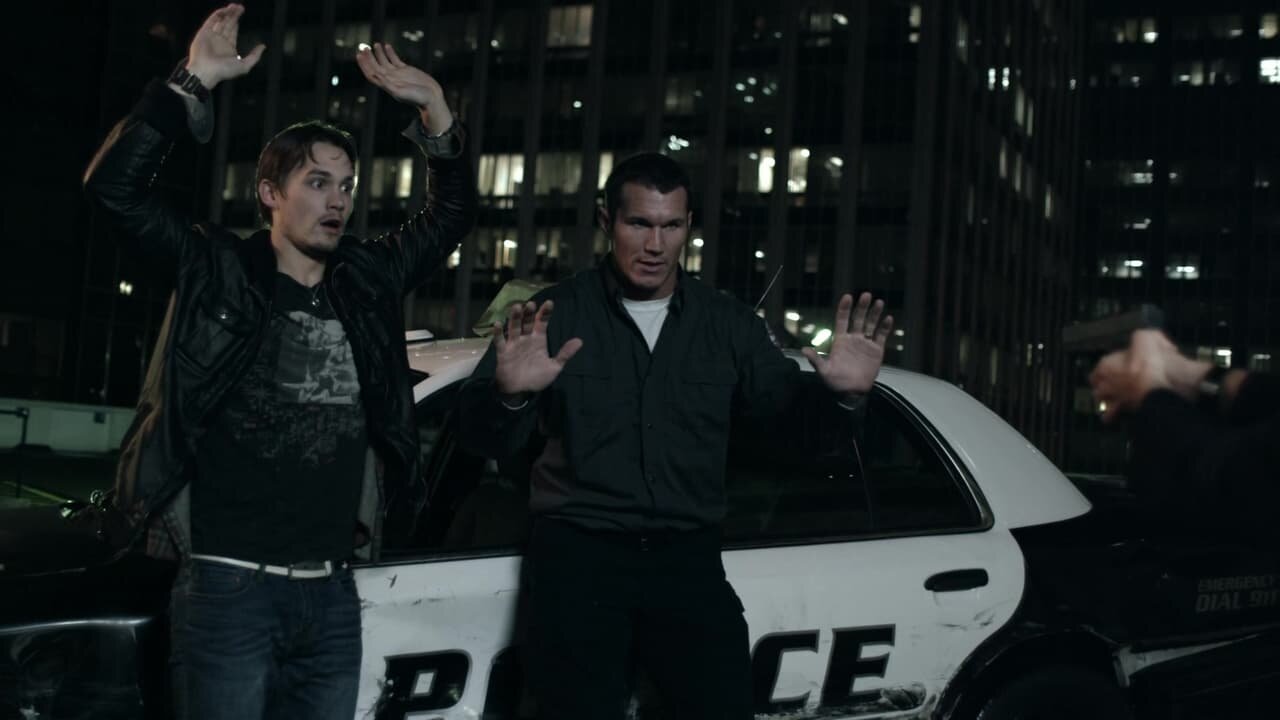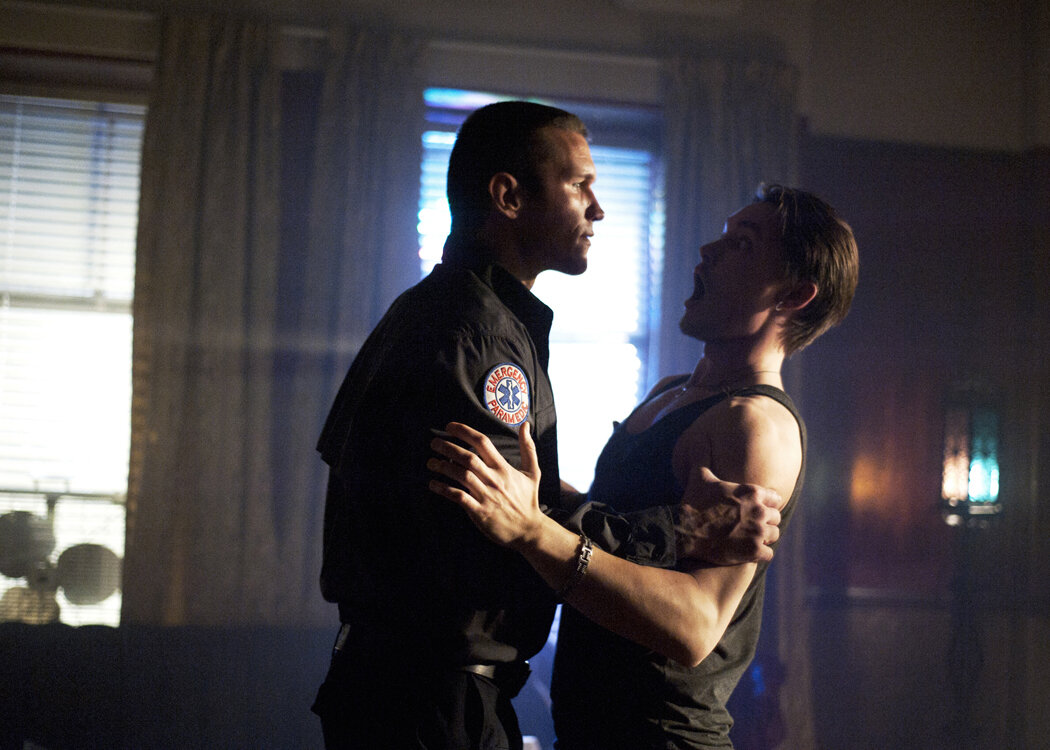Kayfabe Cinema, Fall #1: 12 Rounds 2: Reloaded
WWE superstar Randy Orton tags in for John Cena in this straight to video sequel to the box office bomb, but it’s more hacksaw than hack job.
Kayfabe Cinema is an ongoing feature devoted to the review and analysis of either movies about professional wrestling or featuring professional wrestlers in prominent roles. From high art like Darren Aronofsky’s The Wrestler to pure shlock like Santa with Muscles, the films will be evaluated both objectively as a cinephile and subjectively as a wrestling fan.
Films will be evaluated with the following rating system:
“Botch”- Misses the mark; can’t be enjoyed on any level. Just a bad movie.
“Job”- Imperfect and not quite good, but has some redeeming qualities for what it is. Performs well enough under the circumstances. A loss but not a total failure.
“Over”- Genuinely pretty good; can be enjoyed by wrestling and non-wrestling fans alike.
“Squash”- The movie “kills” it! Has strong artistic merit and is well made. A genuinely excellent film.
12 Rounds 2: Reloaded 2013 (Roel Reine)
Connection to Wrestling: Produced by WWE Studios; starring WWE superstar Randy Orton
Professional wrestler Mike “The Miz” Mizanin plays the gimmick of an entitled, egotistical Hollywood diva. He wears sunglasses indoors, poses for fake paparazzi, and even hosts his own talk show (well, an irregular five minute segment in the middle of the ring). The joke of course is that the heel Miz is pretty delusional. While certainly well known in the WWE circles, Miz is not nearly the star he thinks he is. He’s routinely booed by the crowds, and has the reputation for being a bit soft in the ring, usually winning matches through cheating. However, nothing feeds Miz’s ego quite like his burgeoning movie career. Why wouldn’t it? Miz’s storied career includes not just one but FOUR direct to video sequels to fellow WWE star John Cena’s own star vehicle The Marine. Every few years since 2013, Miz would appear on WWE’s flagship show Monday Night RAW either reporting from the set of such sequels or basking in the glory of his supposed Hollywood success as if he were Tom Cruise and Will Smith combined. These moments are always entertaining as the Miz lauds a movie like Marine 6: Close Quarters like it’s Once Upon a Time in Hollywood. However, the intended irony is clear and validated by the booing crowd: the movies are junk. They are nothing more than quick cash in’s, holding no more artistic merit than a foam finger or a t-shirt. After all, if they were ANY good, they would probably still star John Cena. However, what’s even more ironic is that these films, coarse though they may seem, are actually produced by the WWE. One would think that showing The Miz presenting a trailer during their nationally televised show would be direct publicity, yet they also seize every opportunity to underhandedly mock the film at the same time. How would they expect the niche market of wrestling fans to buy in when they themselves don’t seem to take them seriously?
As a big wrestling fan AND a big movie buff, these cheap action movie cash-in’s were where I drew the line. There’s always a risk of diminishing returns with a sequel, let alone direct to video sequels of theatrical releases sans the original star. WWE Studios has managed to take this trend one step further, sequalizing under performing theatrical releases from bonafide household names like John Cena, The Rock, and Stone Cold Steve Austin and replacing them with lesser known WWE talent like The Miz, Dolph Ziggler, Randy Orton, and Dean Ambrose. It is also strange that the usually family friendly, TV-PG organization produces these films with R ratings, with plenty of the profanity and blood they try hard to avoid on basic cable. Though I was plenty fascinated by the mere existence of this niche subgenre, I could do not bring myself to sit down and watch one.
That is until film critic Ignatiy Vishnevetsky of the The AV Club published a fascinating article in the fall of 2013, claiming that Today’s best action directors aren’t working in Hollywood, but in direct-to-video. He claimed that beyond ludicrous plots and lack of legitimate star power was some of the most well executed filmmaking and action choreography the genre had to offer. He even went so far as to say that some of these wrestler starring cash grabs (such as 12 Rounds 2: Reloaded and The Marine 3: Homefront) that WWE churned out were actually “some of the finest action filmmaking of the past decade—and, in some cases, some of the finest filmmaking, period.” Was the Miz right all along? Was WWE’s most reliable joke actually part of a legitimate action movie renaissance? I had to find out. Though it was impossible to shake my skepticism, I was also excited that I just might be able to guiltlessly indulge in yet another subsect of wrestling fandom. I used to be worried that watching any of these films would be a waste of time, but Mr. Vishnevetsky enabled me. At best, these films were going to be genuinely good sleeper hits; at worst, they would have at least quenched my newfound curiosity. Having an opinion about them was suddenly worth my time.
For some reason, I felt compelled to start with 12 Rounds 2: Reloaded starring Randy Orton. Logically, this made no sense. I had not even seen the first 12 Rounds movie (starring John Cena) and I am not a big fan of Randy Orton. Yet, Vishnevetsky had singled out Dutch director Roel Reine as one of these best action directors on the direct-to-video circuit. This one just happened to be directed by him, not to mention relatively short and available with my Starz free trial. A few years ago, Orton was arguably my least favorite wrestler in WWE. A third generation pro-wrestler, the fresh faced Orton lacked the unique personality of a Rock or Stone Cold, equally lacking any kind of magnetism with the audience. Not that every great wrestler needs a memorable catchphrase, I am hard pressed to remember much of anything that he has said in his almost twenty year career. On top of that, he also happens to be a disgraced Marine who was dishonorably discharged for going AWOL and disobeying a commanding officer. Though not without talent, Orton was a legacy journeyman with one stellar move (“the RKO out of nowhere!”) and an awkward, unnatural trademark pose.
It wasn’t until maybe the last year or so that I started to appreciate what Orton has to offer. While he can come off as a bit of a blank slate as a babyface, he is a sublimely unlikable heel. There is a leisurely nonchalance he embodies when he walks into the ring, almost as if everybody’s time revolves around him. An Orton match can be frustratingly slow at times, but if it’s heel Orton involved, it comes from a place of not wanting to waste his energy for an opponent that’s not worth it. To top it off, the slimy little smirk that crosses his face can make your flesh crawl. He may be naturally unlikable, but, in professional wrestling, there is certainly a place for that.
Like its predecessor, 12 Rounds 2: Reloaded centers around the conceit of a super villain vigilante putting characters through as a series of tests (12 to be exact!) to atone for their past sins. Orton plays Nick Malloy, a paramedic who, on a nocturnal stroll with his wife, stumbles upon a deadly car accident. When Nick fails to revive the fatally injured woman from the wreckage, a year later he is thrust into a full city scavenger hunt that lasts, you guessed it, twelve rounds in order to rescue his kidnapped wife. Spoiler alert, it just might be connected to this very event. He then spends the next 65 minutes or so racing against the clock with a newfound sidekick Tommy Weaver (Tom Stevens), the alcoholic black sheep son of the (now missing) governor (Sebastian Spence). An ominous unknown voice (Brian Markinson, who pacing through a corridor of blinking databases recalls a demented Jeff Bezos) feeds Nick the instructions over the phone. It doesn’t take a cinematic semiotician to figure out that he might be connected to this tragic event, too, because in the world of an action movie, any character with over ten lines of dialogue is somehow connected to the inciting incident. While this is certainly convoluted and a bit corny, from a story standpoint, it does make seemingly insignificant characters actually quite important.
Tom Stevens (left) and Randy Orton (right) in a scene from 12 Rounds 2: Reloaded
It’s easy to dismiss 12 Rounds 2, even if it didn’t star a professional wrestler. Generic is often the adjective of choice for a mass produced capitalist narrative, but it’s really true here. It’s difficult to watch a hulkish protagonist playing mind games on the phone and not think of the literally dozens of similar movies that came before it. Phone Booth, Saw, Speed, Die Hard with a Vengeance, Grand Piano, even 12 Rounds itself. Still, it is amazing what quality you might discover in unlikely places when you look for it. Reine is hardly Gareth Evans and there is nothing especially inventive or risky about his style. However, he is far from a hack either, and there is a certain visual competence on screen that quietly carries this ridiculous story on its back. Reine also works as a cinematographer, and it is clear at the very least he knows how to utilize all the capabilities of the camera to keep a story moving. He certainly does not settle for easy medium shots, and effectively uses high and low angle shots and even the occasional Steadicam to show the fumbling disorientation of having to play such a high stakes game.
While a continuous uncut long shot is the mark of a more artistically minded auteur, Reine interestingly cuts quickly from one specialty shot to another which creates a different kind of tension in its own right. A scene in a sugar factory, for instance, cuts to a distant high angle shot of the governor, sternum deep in a pile of sugar. Shortly after, Tommy and Nick appear on a catwalk above, swiftly running by a sensor that triggers a large conveyor belt full of sugar. Immediately after, a low angle shot reveals more sugar pouring over the governor from a height several stories above him. It then cuts back to Tommy and Nick awkwardly rushing down the stairs with frequent cuts to close up’s of the sugar rushing through the machine. Edited together, this sequence effectively establishes why perhaps dozens of pounds of sugar, dropped from such an intense height, might actually hurt the governor moments before smothering him. In addition, the low angle shots of Tommy and Nick on the catwalk emphasize the great distance between them and the governor, despite technically being in the same room. Also, Reine’s frequent cuts to the machine at work, sometimes with the two men running by it, emphasize that they are in an unstable environment that keeps moving, leaving them no choice but to do the same. The sequence is under a minute long, but its use of camera work and editing accomplish so much dynamism in such a short time.
Reine’s solid work as a visual stylist here means there is in fact some potential for these low culture byproducts to earn some respect as legitimate cinema. However, at the end of the day, wrestling fans are tuning in not to watch skillful editing, but their favorite wrestlers, preferably kicking ass. Unfortunately, Randy Orton’s strengths as an in ring performer do not carry over into feature films. Playing a protagonist means there isn’t much need for his trademark slimy smirk, so we are essentially left with the blankest of slates. There is a fine line between stoic and vacant, and Orton’s performance unfortunately falls into the latter. There is little variation in his monotone line readings or his motionless face, often distorted by shadows (perhaps purposely to hide such lack of emotion?). At times he looks like he is posing for an action figure, stiffly looking straightforward like Wayne on Letterkenny (who himself appears in The Marine 3!). This could almost be all forgiven if Orton resorted to the lowest common denominator and pulled out an RKO out of nowhere on his foes! Wrestlers bringing out the moves is admittedly cheap and pandering but weirdly thrilling in its own way because it brings the fantasy of a wrestler being tough in the real world to life (I’m looking at you, Sasha Banks, in season two of The Manadlorian). Frustratingly, Orton does not fight really much at all here, and when he does, it’s so quick and distorted it might as well never have happened at all. Instead, his character is built on driving various vehicles and doing a lot of talking. It’s reminiscent of the scene in Ed Wood, when professional wrestler Tor Johnson (George “The Animal” Steele) moves from playing mute monster characters to a police detective with tons of dialogue. Reine clearly understands how to shoot a competent action film, so it is a bit puzzling with all the WWE resources at their disposal that they would not spring for a decent choreographer for at least one decent fight sequence. It doesn’t help that Orton’s reflexes are a bit slow, indicative in one scene where he is clearly supposed to abruptly cut Tommy off and drive away. There are at least three solid beats between the last line and this action.
Orton and Stevens, maybe in a fight scene?
Ignatiy Vishnevetsky was definitely onto something when he boldly singled out these direct to video auteurs as the masters of modern action films. I would say he’s the sole defender among his fellow film critics, but that would imply these films are reviewed at all. Rotten Tomatoes has only one review logged of 12 Rounds 2: Reloaded though critic Steve Erickson wrote a feature on direct to video action movies for rogerbert.com, and even singled it out as one of the stronger ones. This proves that these kinds of WWE cash grabs are more assumed to be bad, which would admittedly seem like a safe bet. However, 12 Rounds 2: Reloaded definitely shows that these kinds of films truly can be the kind of films to which the Miz can be proud. Unfortunately, this film and others like it also prove that competent direction cannot always carry the day either, and they are going to need more than a wrestler’s star power to tell a good story. Hopefully in the future, they can write a script that would give Randy Orton a reason to smirk.
Evaluation: “Job”




